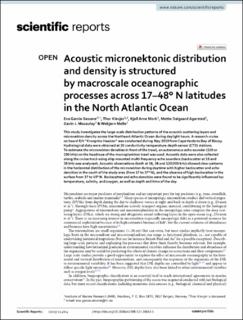| dc.contributor.author | García-Seoane, Eva | |
| dc.contributor.author | Klevjer, Thor A. | |
| dc.contributor.author | Mork, Kjell Arne | |
| dc.contributor.author | Agersted, Mette Dalgaard | |
| dc.contributor.author | Macaulay, Gavin | |
| dc.contributor.author | Melle, Webjørn Raunsgård | |
| dc.date.accessioned | 2023-11-20T09:44:36Z | |
| dc.date.available | 2023-11-20T09:44:36Z | |
| dc.date.created | 2023-05-09T14:38:01Z | |
| dc.date.issued | 2023 | |
| dc.identifier.citation | Scientific Reports. 2023, 13 (1), . | |
| dc.identifier.issn | 2045-2322 | |
| dc.identifier.uri | https://hdl.handle.net/11250/3103505 | |
| dc.description.abstract | This study investigates the large-scale distribution patterns of the acoustic scattering layers and micronekton density across the Northeast Atlantic Ocean during daylight hours. A research cruise on board R/V “Kronprins Haakon” was conducted during May 2019 from Cape Verde to Bay of Biscay. Hydrological data were obtained at 20 conductivity-temperature-depth sensor (CTD) stations. To estimate the micronekton densities in front of the trawl, an autonomous echo sounder (120 or 200 kHz) on the headrope of the macroplankton trawl was used. Acoustic data were also collected along the cruise track using ship-mounted multi-frequency echo sounders (backscatter at 18 and 38 kHz was analyzed). Acoustic observations (both at 18, 38 and 120/200 kHz) showed clear patterns in the horizontal distribution of the micronekton during daytime with higher backscatter and echo densities in the south of the study area (from 17 to 37° N), and the absence of high backscatter in the surface from 37 to 45° N. Backscatter and echo densities were found to be significantly influenced by: temperature, salinity, and oxygen, as well as depth and time of the day. | |
| dc.language.iso | eng | |
| dc.title | Acoustic micronektonic distribution and density is structured by macroscale oceanographic processes across 17–48° N latitudes in the North Atlantic Ocean | |
| dc.title.alternative | Acoustic micronektonic distribution and density is structured by macroscale oceanographic processes across 17–48° N latitudes in the North Atlantic Ocean | |
| dc.type | Peer reviewed | |
| dc.type | Journal article | |
| dc.description.version | publishedVersion | |
| dc.source.pagenumber | 16 | |
| dc.source.volume | 13 | |
| dc.source.journal | Scientific Reports | |
| dc.source.issue | 1 | |
| dc.identifier.doi | 10.1038/s41598-023-30653-5 | |
| dc.identifier.cristin | 2146499 | |
| dc.relation.project | Norges forskningsråd: 280546 | |
| dc.relation.project | EC/H2020/817669 | |
| cristin.ispublished | true | |
| cristin.fulltext | original | |
| cristin.qualitycode | 1 | |
